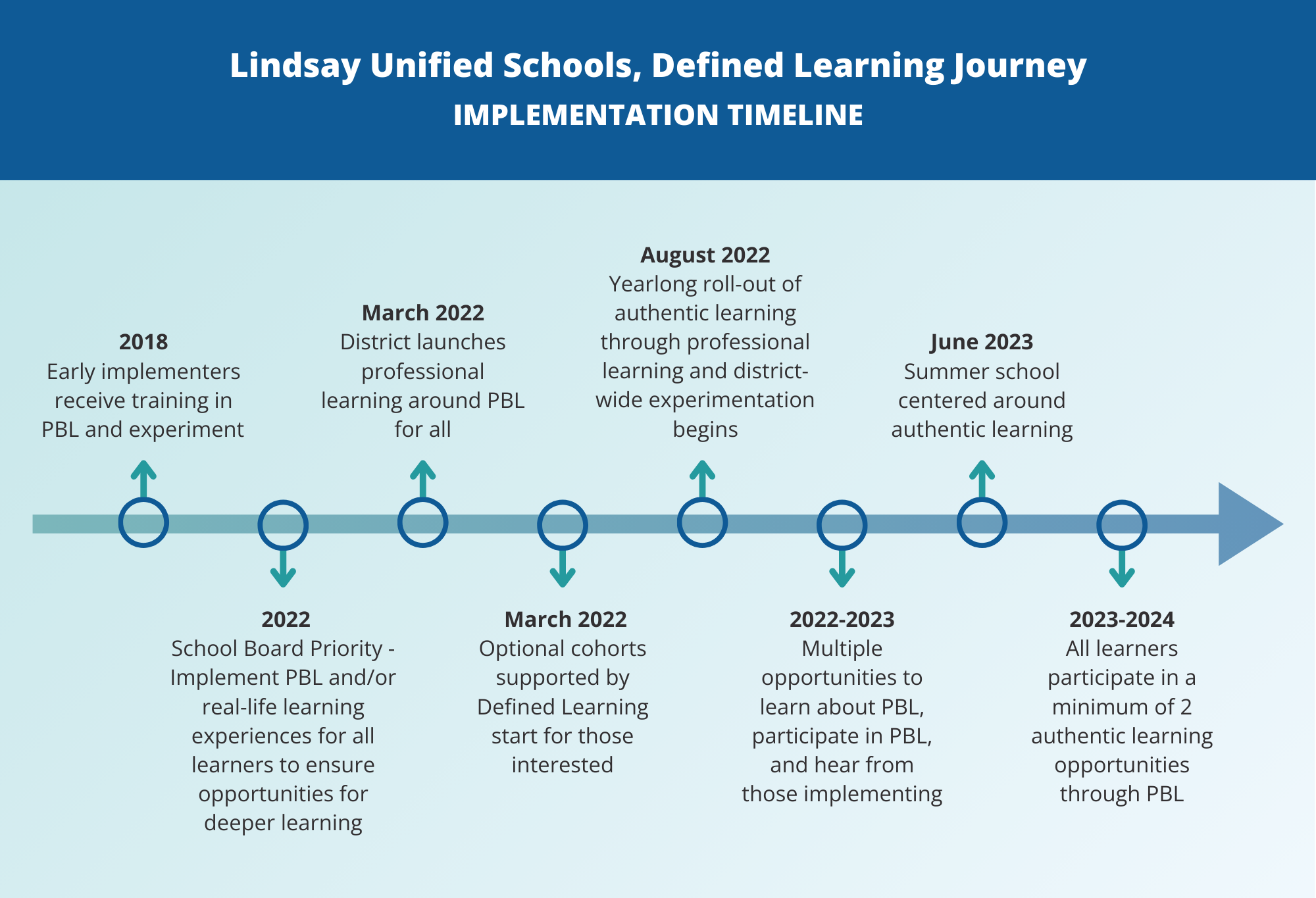Learn how Lindsay Unified School District, a rural school district located in California, created and implemented a competency-based, project-based learning system with the help of Defined Learning.
Lindsay Unified School District in Central Valley California is a 100% Title 1 public school district. The student population is 93% Hispanic/Latino, 31% of whom are English Learners. 43% of the students come from a home where one or more of the parents did not graduate from high school. 30% of the students are migrant learners and the area actually qualifies as its own migrant region. 12% of the students are homeless, and the parents self-report their adult education level at around 5th grade. Lindsay is in the top five districts in the state of adults living below the poverty line.
You might say that Lindsay Unified School District has its challenges, yet district leaders clearly have an asset-based attitude about the community. With consistent academic gains, a 94% graduation rate, and school climate index scores in the 99th percentile, Lindsay’s journey has captured the attention and imagination of education leaders around the world.
For the past 30 years, starting in the 1990s, Lindsay has been on a journey to a competency-based system from an industrial-age traditional system. The culture also shifted from a time-based to a performance-based model of learning, with input from the community and funding from several federal grants that included device access for all students as well as pathways and academics tailored to student interests and ambitions.
Defined Learning, an online K–12 solution that provides educators with all of the tools and resources needed to implement high-quality Project Based Learning (PBL), was selected to ensure opportunities for real-life learning experiences and deeper learning for all learners through PBL.
Project-Based Learning (PBL) was not new to Lindsay Unified School District. Starting as early as 2007, early implementers began experimenting with learning through projects. However, implementing full scale was proving to be a challenge, not because of will but because of how long it was taking learning facilitators to plan their units of instruction. Project-based learning was only taking hold in pockets.
Being competency-based, Lindsay learners must show proficiency before they are ready to move on with their learning, which means not every learner is ready to move on at the same time. This adds an extra layer of complexity for implementation and the strategic design of the professional learning for the staff.
In March of 2022, Lindsay launched professional learning for all learning facilitators as well as specialized cohorts for select staff who were ready for accelerated learning. The method was “try something”. There was no expectation for full projects with exhibitions, but rather get into the platform and try something out. The district provided opportunities for staff to learn from each other as well as from Defined staff, experiencing tasks from a learner’s perspective and sharing successes and challenges as they implemented tasks in their classrooms.
According to Melissa Hawkins, Director of Educational Systems at Lindsay Unified School District, “We provided lots of opportunities to engage and to remove the veil of secrecy around PBL and take away that overwhelming feeling that it takes to plan a huge unit.” During the summer session, learners had the opportunity to experience Defined in a 3-week summer program led by learning facilitators. In the current school year, all learners will have the opportunity to experience two or more authentic learning experiences. The year will culminate with an exhibition of learning to showcase the learning that took place.
Lindsay is a rural district. The students are familiar with agriculture, but they are now exposed to industries beyond their current scope. From miniature golf and animal habitats to aviation and beekeeping, students have a much broader view of future possibilities. Students have sat in cockpits, made music, visited mountains, and created 3D models.
“The Food Truck Vendor performance task is a very popular task because it involves so many different subject areas. Learners map things out, create schedules, design menus, write reviews, and create advertisements. They do some math and they create a model and that’s great, but our learners don’t have access to anything but a taco truck usually. So they were given the opportunity to go to San Francisco, which is about 4 hours away, and go to a place that had multiple food trucks and try out different foods they had never seen before. They got to see in action what it looks like to be part of that bigger city type of environment that they don’t normally get to see on a day-to-day basis,” says Melissa.
Melissa calls it “hidden learning”. The students don’t think about what they are learning in the moment, but the learning is deep and creates multiple entry points in the learning. Students are able to come into the same project at different levels of learning and push forward at their own level and place, which has been powerful for the learners and staff. “Defined Learning has given us an access point to make PBL more doable for our learning facilitators. It’s not just starting with a little kernel of an idea that then takes hours and hours to plan out. They’ve got a base that they can adjust and fix and really match with what their learners need in particular, which has been really powerful.“
